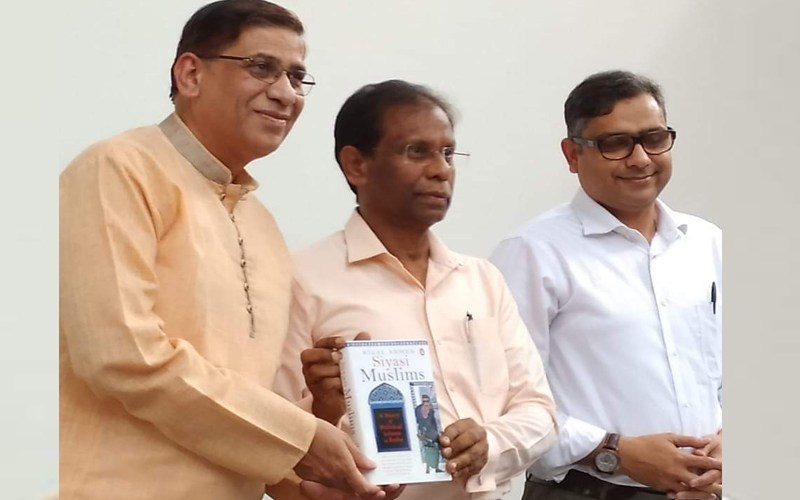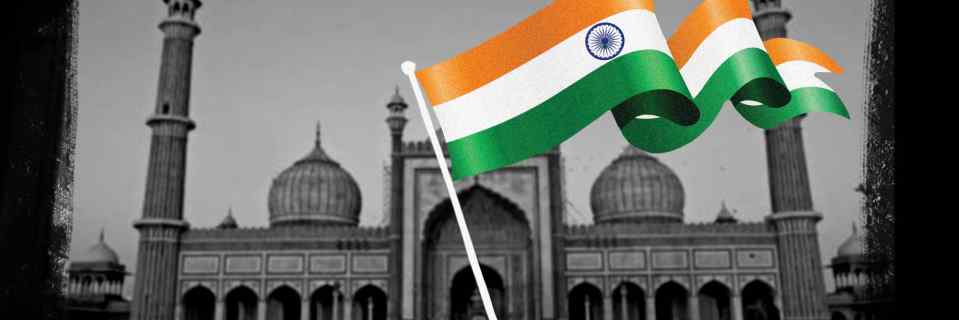NEW DELHI :
Hilal Ahmad addresses contemporary issues like the Gyanvapi mosque and the figure of Aurangzeb. He notes that these controversies are not new, but they resurface whenever right-wing politics gains prominence.

A Brief History Of The Present: Muslims In New India, By Hilal Ahmed Photo: Amazon
Religious polarisation and the rise of majoritarianism in India over the past decade have become a critical concern for scholars in Indian and South Asian studies. The rise of the Hindu right has posed significant challenges to minorities in general and the Muslim minority in particular. Hilal Ahmed, in his book ‘A Brief History of the Present: Muslims in New India’, analyses this Muslim minority question and how it came into being.
The first chapter of this book, titled “Muslimness and Intellectual Politics,” explores the concept of ‘Muslimness’ in two ways: one is explaining Indian Islam as a lived religion while the other is Muslimness as a religious minority in purely statistical terms. The first provides it real-life meaning while the second looks at the Muslim identity in the national or Global question lens.
Further in the chapter, Ahmad explains the nature and ethics of a researcher, addressing himself as Muslim by religion but as researcher who is bound to follow ethics. He quotes Irena Akbar, saying ‘A Muslim must speak as a Muslim’ and then puts up his view as a Muslim researcher, ‘I do not want to give up my identity as Muslim, yet, at the same time, I do not want to talk only Muslim. I follow intellectual politics which encourages me to have a political stand without compromising with the established procedures and ethics of being an academician’.
In the second chapter, “What is New in New India?”, Hilal Ahmad explores the historical changes since 2014 and how they have reshaped Muslim politics in India. He argues that the concept of ‘New India’ is a well-formulated ideological framework, with the current regime promoting initiatives like Swachh Bharat, accessible Bharat, and cashless economy (p. 18). However, Ahmad argues its hollowness in the sense regime takes the credit of such grand initiates yet government takes no responsibility for providing employment. For instance, Prime Minister Modi once remarked that selling pakoras is also a form of employment. Ahmad questions whether this is the reality of New India, where unemployment is rampant, and inflation remains high.
The slogan ‘Sabka Saath, Sabka Vikas’, introduced by Modi in 2014, is scrutinized (p. 20). Ahmad hypothetically argues if it was merely a political move, as actions on the ground suggest otherwise. He highlights how political speeches have often targeted specific communities and promoted fringe elements that commit crimes against minorities, particularly Muslims. Under the guise of cow protection, groups like the BJP-backed Gau Rakshak Dal have been involved in the lynching of Muslims and Dalits. Ahmad questions whether this is truly the vision of New India that began in 2014, signaling the start of a new era.
In the third chapter, titled “New India and the Muslim Historical”, Hilal Ahmad explores how Muslim history is being reinterpreted in the context of New India. He further explains the Modi’s classification of past that India’s history is often divided into three periods: the first is the era of ‘slavery’, beginning roughly 1000 to 1200 years ago; the second is the period of struggle and liberation; and the third, the present, is described as Amrit Kaal (p. 37).
Ahmad delves into the evolving dynamics between so-called liberal Hindus and Hinduism, noting a shift in the stance of secular Hindus. Those who once championed pluralism, secularism, and socialism are now silent in the face of rising Hindu communalism. He argues that there is nothing inherently wrong with liberal intellectuals embracing Hinduism as an important identity marker, but he warns that this intellectual shift is dangerous as it subtly excludes Muslims under the guise of opposing an imagined anti-Hindu sentiment.
For example, Ahmad points to Pavan Kumar Varma, an Indian diplomat and author. Varma once praised the Mughal empire in his book “Ghalib: The Man, The Times”, but in a later work, “The Great Hindu Civilization: Achievement, Neglect, Bias and the Way Forward” (2021), he argues that the arrival of Islam in India disrupted the ‘unadulterated flow’ of the pure Hindu past (p. 41). Ahmad highlights this shift among liberal Hindus, who are becoming more aligned Hindutva, while remaining silent on issues facing minorities. He also notes that this silence is not limited to liberal Hindus but extends to so-called liberal Muslims as well.
In the fourth chapter, titled “New India and the Muslim Cultural”, Hilal Ahmad addresses contemporary issues like the Gyanvapi mosque and the figure of Aurangzeb (p. 65). He notes that these controversies are not new, but they resurface whenever right-wing politics gains prominence. While these issues may have little direct impact on the daily lives of ordinary citizens, the BJP has made them a central part of its political agenda to garner Hindu votes.
Ahmad explains how Hindutva groups, such as the RSS and VHP, claim that many historical monuments, like the Gyanvapi mosque, were originally Hindu temples that were demolished by Muslim rulers. These narratives are strategically used to reinforce communal divides and fuel the BJP’s political ambitions.
In the fifth chapter, titled “New India and Muslim Religion”, Ahmed explores the concepts of religiosity, Muslim self-consciousness, and the rise of Islamophobia or what he terms ‘Muslim politicophobia’. He explains how the growing extremism of Hindutva has fostered a sense of collective identity among Muslims. Ahmed differentiates between Islamophobia, which refers to an intense dislike or fear of Islam or prejudice against Muslims—a notion rooted in Western discourse—and Muslim politicophobia, a more specific phenomenon in India. The fusion of global anti-Islam sentiment with India’s own brand of anti-Muslim communalism has created a new political consensus, which Ahmed refers to as ‘Muslim politicophobia’ (p. 76).
In the sixth chapter, titled “New India and the Muslim Liberals”, Ahmed explores the question of who qualifies as a liberal Muslim. Many creative individuals—artists, authors, academics, and journalists—who speak out against illiberal tendencies and religious extremism as a moral responsibility are referred to as liberal Muslims. The term has two popular interpretations. One refers to individuals who uphold liberal, egalitarian values while maintaining their cultural and religious identity as Muslims.
Ahmed raises several key questions regarding liberal Muslims: What is their sociological position, particularly in relation to the highly diverse and heterogeneous Muslim identity? How has the rise of Hindutva challenged their status and legitimacy in public life in recent years? And what qualifications are now required to be considered a “good Muslim” within the Hindutva-dominated discourse? The notion of the ‘liberal Muslim’ is, in fact, a byproduct of India-specific, market-friendly liberalism. Ahmad Argues that it is important to note that this category has always been fluid and open-ended, encompassing progressive Muslims, socialist Muslims, cultural Muslims, and secular Muslims. (p. 94)
In the seventh chapter, titled “New India and the Muslim Social”, Ahmed delves into the Pasmanda discourse, BJP’s strategies, and Muslim caste dynamics. He points out that the discourse surrounding Pasmanda Muslims is not a recent creation of the BJP’s political strategies. Muslim intellectuals have long discussed how the BJP has attempted to divide Muslims along lines of caste, sect, and differences between Shias and Sunnis. Ahmed highlights how the BJP frames its narrative to gain votes from Dalit Muslims (Pasmanda).
In the second section of the chapter, Ahmed discusses BJP’s professionalism, noting that the “politics of professionalism” often goes unnoticed in public debates. While Hindutva ideology is frequently overstated as the primary driving force behind BJP’s politics, the party’s electoral strategies and mobilization tactics extend beyond Hindutva rhetoric. This creates the impression that the BJP is strictly pursuing a vision of ‘cultural nationalism’ in overtly Hindu terms, while its political maneuvers are more nuanced and professional.
In the eighth chapter, titled “New India and the Muslim Political”, the author examines Muslim political attitudes, distinguishing between political participation as interaction and political participation as instrumental action. He maps out the various dimensions of Muslim political behavior in contemporary India.
In his concluding remarks, Ahmed brings together the key insights of the book, offering a comprehensive understanding of the political status of Muslims in New India. He emphasizes that, despite the BJP’s ongoing efforts, the party still manages to secure only 8-9% of the Muslim vote. Ahmed presents his arguments in a coherent manner that ties together the broader themes of the book, making it a valuable resource for academics, everyday readers, and politicians alike who wish to understand the minorities issues facing New India.
(Haider Ali did his masters form Jamia Millia Islamia, Mohammad Asif is pursuing his Ph.D. from Jamia Millia Islamia)
source: http://www.outllookindia.com / Outlook / Home> Books / by Haider Ali & Mohammed Asif / November 09th, 2024














